
Pumice-crete is a mix of pumice aggregate (a very porous volcanic rock), portland cement, and water. The mix is mostly pumice with only enough cement to bind it together. This is considered a “lean mix” which maximizes the thermal insulating qualities of the walls. The mix is poured into forms creating 14” thick exterior walls and 8” thick interior walls. For more on pumice-crete visit http://www.pumicecrete.com/Pumice_Definition.htm.
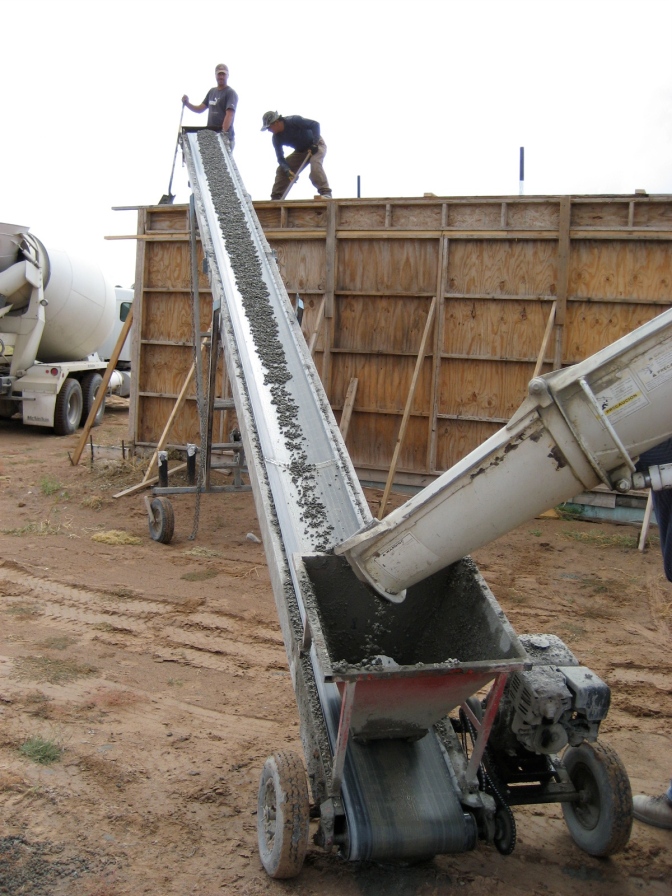
The forms were made of plywood that we were assured were about 9 years old (and were therefore well off-gassed). The forms are removed and are not part of the finished house.
Before it is plastered, a pumice-crete house resembles a giant gray rice krispy square:

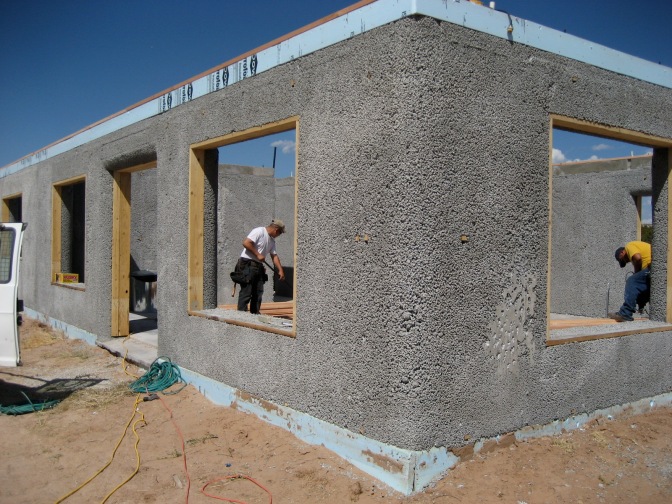
You can frame the interior walls and use drywall (or some other wallboard) over the framing, but I did not find any wallboard product that was safe for me. At the time, a consultant we hired insisted MgO board was safe, but I tested it three times and reacted each time. (For more on MgO board, visit this very helpful website on building healthy: http://www.mychemicalfreehouse.net/
Finally we decided the safest option was to have the pumice-crete contractor pour the inside walls as well. The blue Styrofoam insulation you see in the above photo is on the outside of the house and was covered with cement and stone on the bottom and Denny foil and wood at the top.

The interior walls of our house were then finished with an earth plaster (adobe earth, sand and water) made on site.
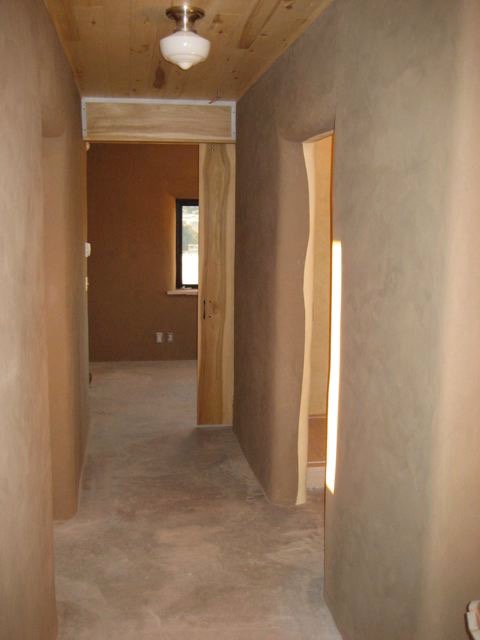
The exterior walls were finished with lime plaster (powdered lime, natural yellow ochre earth pigment, sand and water). Mold will not grow on lime plaster because of its elevated PH (in other words it is very alkaline) so we finished the bathroom walls in lime plaster as well.
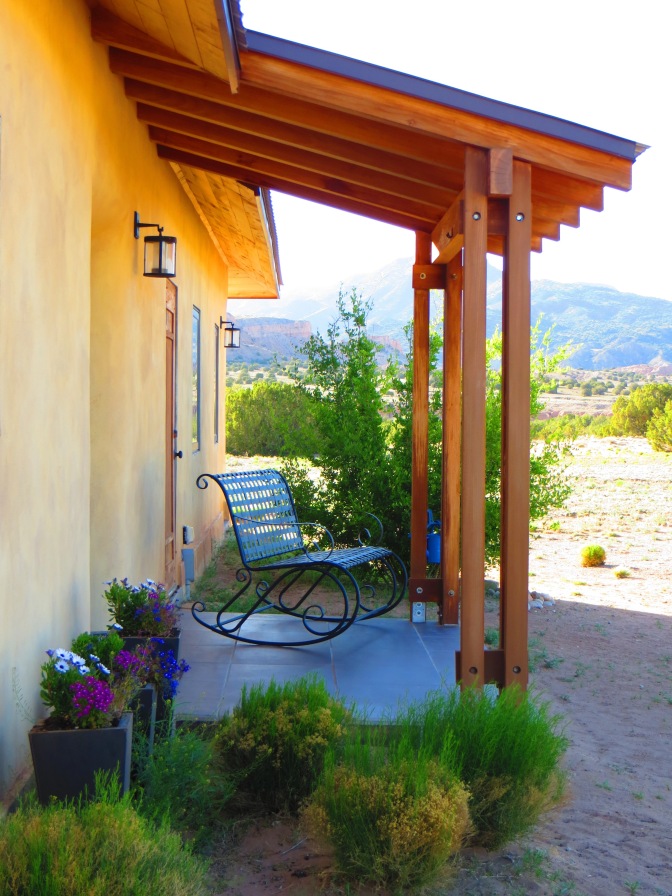
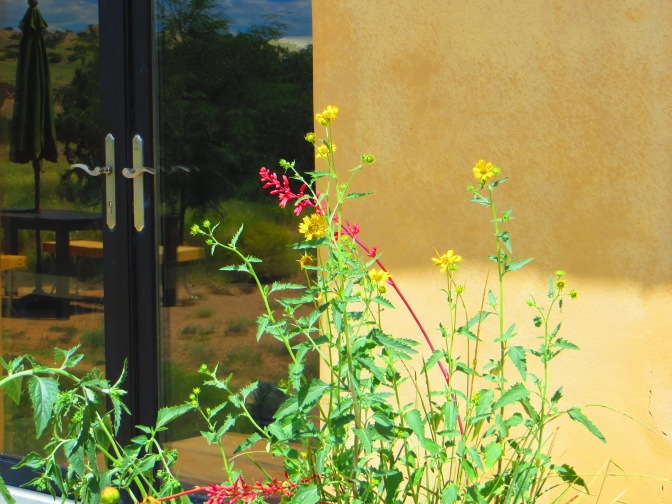
Finishing with natural plasters eliminates the need for any paints inside or outside the home. In the future, if we need to repair cracks or chips, the natural ingredients in these plasters will not off-gas anything toxic into the air and are therefore appropriate for homeowners who cannot tolerate products that will off-gas for days or weeks (or months) into the air they breathe.
We considered rammed earth construction as well as adobe, but both of these methods of building required insulating the interior walls. This meant that stud walls filled with some form of insulation and covered in some form of wallboard would line the entire interior perimeter walls. Sorry to state the obvious, but in healthy house building, one is constantly trying to avoid adding materials that will be questionable or require off-gassing or airing out. In the above example, the studs would be made of what builders call SPF or wood made of spruce, pine or fir—these are all woods that contain terpenes. Terpenes are fragrant, naturally occurring oils and resins that many chemically sensitive people react to.
“The natural resins in softwood lumber outgas terpenes and other volatile organic compounds (VOCs). Terpene vapors may be unhealthy to breath. For those with chemical sensitivities, terpenes are often intolerable.” For more on this, visit www.healthyhouseinstitute.com.
Insulation would then be installed between the softwood studs. I tested many brands of insulation and I reacted to all of them. (We obviously did have to insulate the roof. I will discuss the solution we came up with in another post.) And finally, wall boards like drywall, particle board, mdf (medium density fiberboard) and plywood are all manufactured products with varying degrees of toxicity due to their materials, glues (often formaldehyde), and adhesives. The wallboard would then have to be painted or sealed. With pumice-crete, we could avoid all of these materials. By choosing pumice-crete walls, all these materials are replaced with pumice aggregate, a small amount of cement, water, and an earth plaster finish. The R-value of the completed wall (official definition: the capacity of an insulating material to resist heat flow) is in compliance with New Mexico state requirements for insulation.
No wall material we researched for our house was without some alarming issue and that includes pumice-crete. The biggest downside of pumice-crete is the elevated radon levels found in this volcanic rock. These levels vary depending on the quarry the pumice comes from, but the pumice-crete houses we tested in 3 buildings under construction in Taos were 50 to 100% higher than background radon levels. That sounds dramatic but it is actually normal for radon levels to be that much higher inside a building than outside according to the EPA publication Protocols For Radon And Radon Decay Product Measurements In Homes. (not a fun read, by the way) The EPA recommends radon levels should be 4 pCi/L or less. Unfortunately, our device measured radon as cpm or counts per minute not pCi/L or picocuries per liter. So. We never found out the picocurie per liter number and still do not know what the average is for pumice-crete houses in general or ours in particular. Feel free to enlighten/freak me out with this information if you have it and I will add it to this post.
We were nervous about this elevated radon issue of course and we abandoned pumice-crete for months while we searched for other alternatives. We found more challenging problems with the other options and finally came back to pumice-crete after a conversation with environmental health and chemical sensitivity consultant Dr. Ann McCampbell. For more on Dr. McCampbell click here: http://annmccampbell.com/sample-page/bio/
“I’d take my chances with pumice-crete,” she said and then explained that a survey of chemically sensitive patients who built healthy houses showed that those who built pumice-crete houses were more satisfied with their houses than those who chose other methods.
Another downside of pumice-crete is that a lot of water evaporates out of the walls for a year or so. The house was very humid, particularly during the warmer summer months, as the 14” thick walls released their water. This was irrelevant for me since I couldn’t live in the house for a year and a month after it was finished anyway. So many materials have to off-gas from a healthy house, from plumbing products to the AFM SafeSeal we sealed the tongue and groove ceiling with. (I will share some alternate ceiling ideas when I get to that post.)
I still can’t believe the house worked out and is safe for me to live in and am an enthusiastic supporter of pumice-crete as a building material. I do, however, open doors and windows to thoroughly air it out everyday, including in winter, since ventilation reduces radon considerably.
*If you decide to build with pumice-crete, ask that no chemical additives (hardeners or waterproofers, for example) are added to the cement mix.
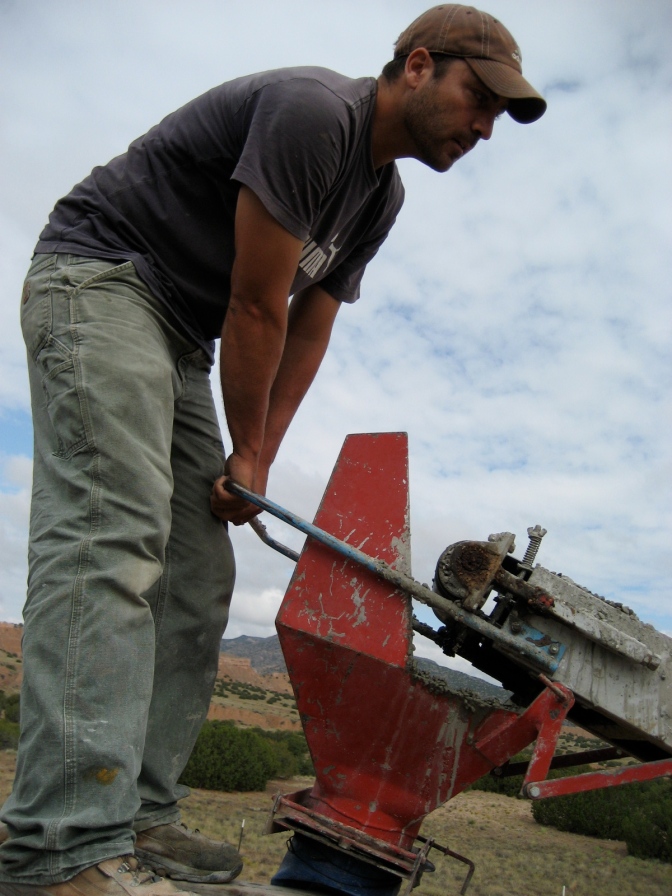
Our pumice-crete contractors in New Mexico were Scott and Evan MacHardy of Pumice-crete Building Systems (Evan is pictured above.) I would recommend them highly.
Scott MacHardy, Pumice-Crete® Building Systems of New Mexico
PO Box 539
El Prado NM, 87529
Nice very nice, we have lived in a Pumice Crete home for 18 years now, in La Missila, by The Black Mesa along the Rio Grande Bosque. Your article is great. Just what Pumice Crete is.
James Lujan
LikeLike
Thank you–glad to hear from another Pumice Crete homeowner. I love The Black Mesa, so beautiful.
LikeLike
I knew a few folks who used pumice crete when I lived in NM and thought about using it to build. Unfortunately, pumice is not as readily available in my area and I started looking for alternatives. I believe foam crete will do nicely.
Loved your post. You might br able to use this conversion site to get an answer on your radon levels, btw:
https://www.translatorscafe.com/unit-converter/en/radiation-activity/compact/
LikeLike
We were wanting to use foamcrete but have been having problems with form leakage. Because of that we’re considering pumice-crete, but it’s not available in East Texas and we haven’t found a source.
LikeLike
Wonderful article! I have fibre and am very sensitive to chemicals. We were considering earthbag with Scotia since we live up north. Pumice Crete in block from would be nice for we do it yourselfers.
LikeLike
These builders have used a pumicecrete block to build this house in Belen, NM: http://earthentouchbuilders.com/gallery-category/pumice-crete-block-home-belen-nm/
I don’t know where they bought it, but you could reach out to them if you are still trying to find pumicecrete blocks. If you built a healthy house already, I would love to hear what materials worked and what didn’t.
LikeLike
Hi, nice article and very nice house. Just wondering what is the proportion you used for the pomice-crete
LikeLike
This is from our pumicecrete contractor’s website: “Our basic mix for exterior walls on a single story structure uses under 3 sacks of portland cement for every cubic yard of aggregate with water being the only other ingredient. This material reaches 400 PSI strength quickly and has a thermal insulating value that I estimate to be R-I.5 or more per inch. It is no where near the structural strength of typical concrete used today which are usually 2000 PSI and above but those strengths are not necessary in thick wall situations.” Hope that helps.
LikeLike
Hi, how is the insulation compared to adobe? Does it stay cool in summer and warm in winter?
LikeLike
The insulation is excellent in winter. It is toasty warm and the least drafty house I’ve ever lived in. Unfortunately, the masonry walls do absorb heat in summer and can radiate heat in the late day and evening.
LikeLike
HI Margaret. WE have land in Taos ,thinking of pumice as an option. Im wondering if you could share your contractors . I live in NY. I have been told by many contractors there is a waitlist of 2-3 years for home construction.
great article ,thanks !
LikeLike
Scott Machardy’s phone number is 575-751-3076. His son Evan is also a builder and has his own company. His number is 575-737-1169. Evan worked on our house and was great to work with. Good luck with your project!
LikeLike